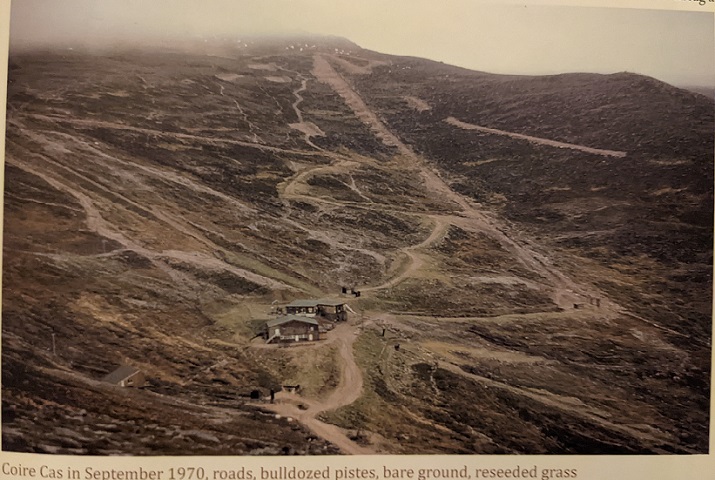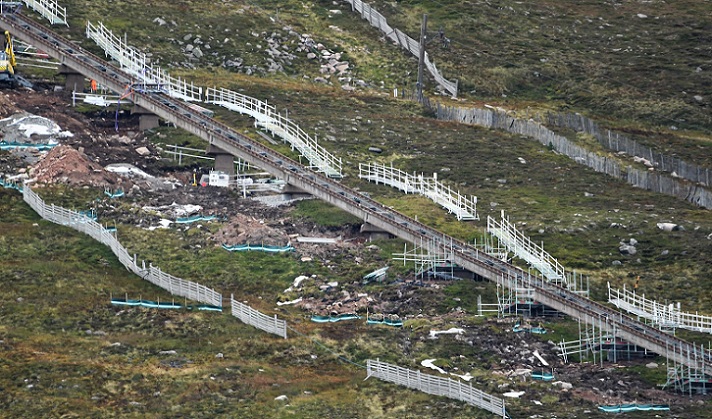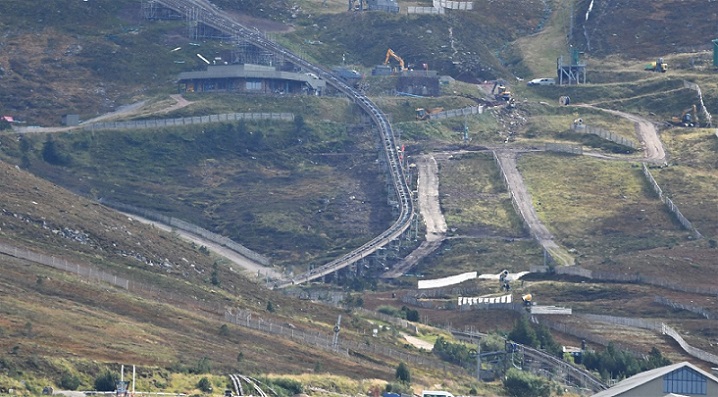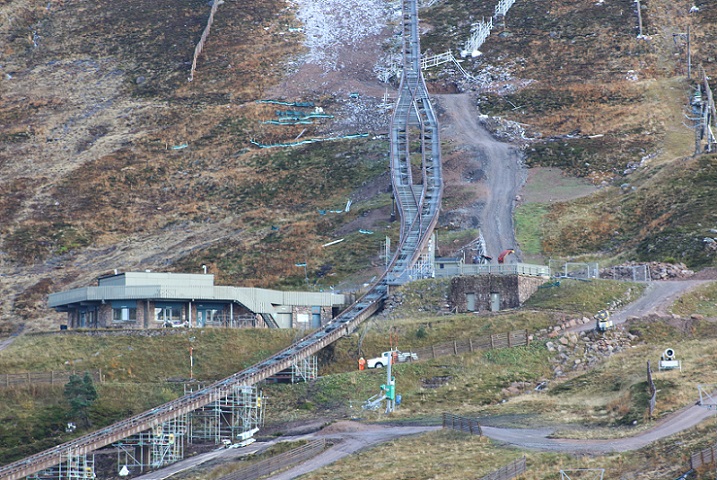
I had not intended to leave it two months before featuring another of Adam Watson’s photos (see here). He took this photo of the upper part of Coire Cas shortly before the Lurcher’s Gully Public Inquiry in 1981 at which he presented scientific evidence about the impact of ski developments at Cairn Gorm.
Ten years earlier Adam Watson had taken another photo from the same vantage point. This is featured on the cover and inside his book “Human impacts on the Northern Cairngorms” (published 2012) the first half of which contains the evidence he presented to the Lurchers’ Inquiry:

Despite the re-seeding by the end of the 1970s Coire Cas was hardly in a better state than at the beginning.
At the Lurcher’s Inquiry Adam Watson presented evidence about snow-patch vegetation – the plant communities that can survive for long periods under snow – which he regarded as the most reliable indicator of areas suitable for skiing. The longest single stretch of such vegetation in the northern corries, 1720 metres, was in Coire na Ciste. The longest stretch in Coire Cas, 710m was down the White Lady, followed by 700m along the Allt a Choire Cas. There was a 300m stretch of snowpatch vegetation on Fiacaill a Choire Cas – the ridge on the right in the photo – so it is hardly surprising that most of the time the opportunities for skiing there were quite limited.
Despite the evidence about snow lie, it was in Coire Cas that the Highlands and Islands Development Board tried to concentrate downhill snowsports and the result was the widespread destruction visible in these photos. By removing the lift infrastructure in Coire na Ciste, Highlands and Islands Enterprise have abandoned the area best suited to snowsports at Cairn Gorm.
What Highlands and Islands Enterprise now appear to be trying to do is to turn Coire Cas from a failing ski area into a summer playground. In doing so they have subjected it to further extensive earthworks and there are more in the pipeline. These include:
The work to repair the funicular by propping up and strengthening the foundations of its leaning towers;

New roads around the Shieling;

Four new roads have been created since Adam Watson took his photographs. To the left of the “new” Shieling Building, which is no longer in use, there are two short roads visible: the slanting (grey) one on the left was the subject of my recent post on new roads on Cairn Gorm (see here); the zig zag road to the right never had planning permission but Cairngorm Mountain Scotland Ltd is now proposing to remove it. To the right of the funicular are two parallel roads: the one on the left is part of the funicular repairs and is supposed to be temporary but covers part of the area where it is now proposed to create a mountain bike track; the one to the right – the Shieling track – was created unlawfully but granted retrospective planning permission by the Cairngorms National Park Authority in January 2017 (see here).
Above the Shieling there is more:

Since Adam Watson took his photos the ground in Coire Cas has continued to be re-worked on a regular basis. Despite his efforts to reduce human impacts on Cairn Gorm, while providing better skiing, HIE has continued to treat Coire Cas like a building site. What was left of natural landforms and vegetation cover following the original ski development and subsequent construction of the funicular continues to be eroded away, bit by bit.
Why, one might ask, does this matter if the place is so trashed? Part of the answer, as Adam documented in “Human impacts”, is that ground disturbance weakens soil cohesiveness and is associated with floods and surface erosion. The ground is inherently unstable, glacial material on a weathered granite base, and the soils poorly bonded. Under the influence of gravity and water it is all moving downhill and that is the most likely explanation for the tilting funicular towers. The current funicular repair works will at best only slow those processes down but at worst could destabilise the slope further. There has been no assessment of those risks.
The story behind Adam Watson’s 1981 photo is as relevant now as it was then. That should be reason enough for the Cairngorms National Park Authority to take a precautionary approach to creation of any new roads at Cairn Gorm and the planning application to create beginners’ mountain bike tracks which I will consider in a further post.
Last Friday, 25 Feb, I went to Cairn Gorm and, from the car park in Coire na Ciste, ski toured up Coire Laogh Mor and down Coire na Ciste, on my skis the whole time. The run down the Ciste was the only reasonable ski descent available on Cairn Gorm that day. This supports the data on snow lle that was diligently collected by Adam Watson through most of his lifetime. But the owner of these upper mountain slopes is Highlands and Islands Enterprise. The continuing refusal of HIE to recognise the significance of the Ciste for snowsports development and their refusal to prioritise uplift development in this corrie is the height of stupidity and worse. I also worked with Adam Watson in the preparation and delivery of scientific evidence to the 1981 Lurchers Gully Public Inquiry. That evidence helped to persuade the Secretary of State for Scotland to refuse planning permission for the proposed road and uplift developments into Lurchers and the adjacent corries. But it also included dire warnings about the potential dangers of catastrophic flooding in Glenmore if bare ground continued to spread in Coire Cas through excessive development of roads and other infrastructure. HIE has still not learnt these lessons. Their continuing presence on Cairn Gorm, their future strategy for development and their management competence is a source of amazement. This is bound to lead to an economic and environmental disaster. Politicians need to act now and make radical changes to how this mountain is valued, how it is used and how the upper and lower slopes are to be safeguarded.
Coire Cas is now an industrialised mess which is set to become even worse when the CNPA rubber stamp the latest planning applications. If Dr Watson’s advice had been heeded then snowsports within Coire na Ciste would have enabled the hill business to trade effectively throughout the period of the Funicular closure [and the money being wasted on its repair could haver further enhanced the hill infrastructure…or been used to dismantle it, preferably]. Instead, there’s a hotch potch of piddling little developments such as the tube slides that will never enable the business to reach commercial sustainability. Of course, HIE have already admitted that their strategy is set to continue to fail, into the future. If that wasn’t the case then a continuing public subsidy would not be needed….but…..that is what their plans reveal.
What a disaster – it’s awful. I can’t bear to see it.
Like Dave Morris, I also helped Adam to prepare his evidence with numerous joint visits to Coire Cas pre the 1981 enquiry. On behalf of North East Mountain Trust, which I represented at the inquiry, we also presented Rod Ward who has just finished a three year study on factors influencing snowlie in the Cairngorms and he showed why the Northern Corrie would had poor snowlie. We also presented Dr Friz Schwarzenbach inspecting his 500the ski development who assessed Cour Cas as the worst designed ski development he had ever inspected. Dave Morris is also right to draw attention to how Adam pointed to the potential environmental disaster. One of the things we learned from experience elsewhere was that erosion on mountains was often not simply a gradual process. What happens is that action lead to the area becoming increasingly damaged and vulnerable. The along comes one of these major climatic events that Mountains experience and there is a major disaster. Coire Cas is heading that way.
Having worked for the Cairngorm Chairlift many years ago in Coire na Ciste, , or to give it the name everybody in the company knew it as, “Sleepy Hollow”, skiing there was just not that popular.
At the end of the day when you got picked up and taken round to the Cas to get the bus home, it was always suprising how busy the mountain and Cas side had been.
The Aonach bowl could have powder snow for weeks and yet next to no customers, i worked that tow for a few winters.
The last time i took a drive up to the Cas the snow making machine was getting through 1000 litres of diesel a day and drawing water from the steam, i know it is now using Bio fuel but not a word on that enviromental disaster.
Put money into the Ciste side of the mountain, i’ll pass on that investment opportunity